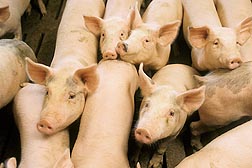Recycling Ammonia Emissions as Fertilizer
Published: November 6, 2012
By: Ann Perry (USDA- Agricultural Research Service)
One of the costs of running a farm can include buying nitrogen in the form of anhydrous ammonia to fertilize crops. But there are other agricultural costs associated with nitrogen, especially when the nitrogen in livestock waste produces pungent—and potentially harmful—ammonia emissions.
But on June 20, 2011, Agricultural Research Service soil scientists Matias Vanotti and Ariel Szogi filed U.S. Patent Application #13/164,363 for an invention that could help change on-farm nitrogen management. It’s a system that uses gas-permeable membranes to capture and recycle ammonia from livestock wastewater before the ammonia goes into the air. The two scientists, who work at the ARS Coastal Plains Soil, Water, and Plant Research Center in Florence, South Carolina, found that they could use these membranes to reduce ammonia emissions from livestock waste and capture concentrated liquid nitrogen that could be sold as fertilizer.

Ammonia emissions from livestock waste can be more than a nuisance—they can harm animal health. But ARS scientists have shown that gas-permeable membranes can remove and concentrate the ammonia for eventual sale as fertilizer.
The membranes are similar to materials already used in waterproof outdoor gear and in biomedical devices that add oxygen and remove carbon dioxide from blood. Using these materials, the scientists recorded an average removal rate of 45 to 153 milligrams (mg) of ammonia per liter per day when manure ammonia concentrations ranged from 138 to 302 mg ammonia per liter.
When manure pH increased, ammonia recovery also increased. For instance, the scientists were able to recover around 1.2 percent of the total ammonia emissions per hour from manure with a pH of 8.3. But the recovery rate increased 10 times—to 13 percent per hour—when the pH was 10.0.
In a follow-up study, Vanotti and Szogi immersed the membrane module into liquid manure that had 1,290 mg of ammonia per liter. After 9 days, the total ammonia concentration decreased about 50 percent to 663 mg per liter, and the pH decreased from 8.1 to 7.0. This meant that the gaseous, or free, ammonia in the liquid—the portion of the total ammonia linked to ammonia emissions—decreased 95 percent from 114.2 to 5.4 mg per liter. Using the same process in 10 consecutive batches of raw swine manure, they recovered concentrated nitrogen in a clear solution that contained 53,000 mg of ammonia per liter.
“When we started this research more than 10 years ago, the membranes were very expensive,” Vanotti says. “But the prices have come down, so its use for recovering the ammonia in manure is now much more cost effective.”
The scientists want to scale up the process to see whether the membrane modules would lower ammonia emissions when installed in manure pits below the slotted floors in swine barns or in manure tanks and lagoons. If so, they believe that livestock producers could use the technology to help meet air-quality regulations, save fuel, protect the health of livestock and their human caretakers, improve livestock productivity, and recover nitrogen that can be sold as fertilizer.
This article was published in the November/December 2012 issue of Agricultural Research magazine. Engormix.com thanks for this contribution.
Source
Ann Perry (USDA- Agricultural Research Service)Related topics:
Recommend
Comment
Share

Would you like to discuss another topic? Create a new post to engage with experts in the community.







